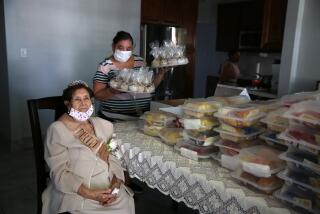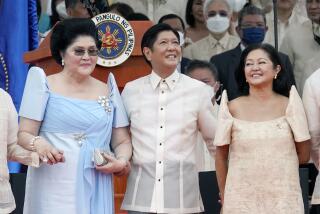A Peek at the Manila Palace Imelda Called Home
- Share via
MANILA — It’s more than the shoes--a lot more.
When Philippine President Ferdinand Marcos and his jet-setting wife, Imelda, fled the country in February, 1986, during a revolution that brought Corazon Aquino to power, the media poured out stories of their lavish life style at Malacanang Palace in Manila, the home of Philippine presidents since 1935.
Most of the articles focused on Imelda’s collection of 3,000 pairs of shoes. They’re still there, but are really only a small part of the voluminous number of items she and her husband amassed during his 21-year reign.
Piles of their former possessions are displayed for public viewing now that Malacanang is open as a tourist attraction.
Malacanang is a magnificent colonial structure that can be traced to the Spanish occupation of the Philippines in the 19th Century.
Underwent Reconstruction
In the 1970s the palace underwent reconstruction under Imelda’s supervision. I found the interior, with its dark, wooden paneling mostly on the gloomy side. The face lift included bullet-proof windows and the elimination of windows entirely in the ex-president’s bedroom.
Before entering the palace be prepared to run a gantlet of young hawkers with T-shirts emblazoned with Aquino’s rallying cry, “People Power,” and canned soft drinks.
Malacanang is on the right bank of the Pasig River in Manila’s San Miguel District.
The tour begins in the entrance hall fronting the circular palace driveway. Its marble floors lead to the grand staircase, the imposing state reception rooms and Heroes Hall, where the Marcoses entertained heads of state and where Imelda liked to lecture to visiting groups.
According to reports she was prepared to take on a variety of subjects, including international relations, geopolitics and Philippine history and ideology.
The palace also contains furniture dating to American rule. One American-acquired piece is a beautifully carved table in Elizabethan style in Heroes Hall.
An Imelda Touch
Keep a sharp eye while going up the grand staircase. One of Imelda’s touches was covering the walls with thousands of tiny pieces of wood assembled to simulate ancient Filipino paneling. Also, lining the staircase are several portraits of Spanish conquistadors, among them Hernando Cortes, plus explorers Ferdinand Magellan and Cristobal Colon (the Spanish rendering of Christopher Columbus).
Before you get to the Marcos’ private quarters where their trove lies, the palace offers a few other rooms. One is Ceremonial Hall, the largest in the building, whose main features are three huge wood-and-glass chandeliers carved by nationally renowned artist Juan Flores into masterpieces of Philippine artistry.
Also impressive is the enormous reception hall, where guests waited before being ushered in to meet the president or first lady. Here three exquisite chandeliers also dominate. Imported from Czechoslovakia in the 1930s, they were removed during World War II and hidden prism by prism.
Ferdinand’s bedroom is like an oversize hospital room, which, in a sense, it was. It was just as he left it when he and Imelda scurried away to Hawaii on Feb. 25, 1986. Among its contents are a dialysis machine (he reportedly suffers from kidney failure), adjustable hospital bed covered by mosquito netting, a rollaway steel table loaded with medical supplies and other medical paraphernalia.
On one side of the room were three mattresses. We were told that the president occasionally liked to have his grandchildren sleep with him in the room. Off the bedroom is an actual hospital room and the floor below houses an operating room. Doctors were in attendance at all times, we were told.
An Attention-Grabber
Imelda’s bedroom is almost as large and much more ornate. The canopied bed takes two queen-size mattresses but what grabbed my attention was a full-length, three-panel mirror lighted from top to bottom. There also is an Austrian-made Bosendorfer piano and an adjoining bathroom accented in green malachite.
A door from her bedroom leads to the family chapel, which also sports a ceiling-to-floor mirror. Imelda wanted to see herself praying, according to a guide.
A dressing room off her bedroom, with it rows of garments, provides only a hint of what’s to come.
Yes, the shoes, the clothes--mountains of clothes. They’re in the family “wardrobe room” on the ground floor. The shoes, with handbags and other accessories to match, are arrayed neatly on shelves. I didn’t count them but I bet there are 3,000 pairs--if not more. On nearby racks were hundreds of cocktail dresses, evening gowns and other frocks.
An American woman, noting that some dresses were outdated, remarked: “I’ll bet she kept every dress she ever bought.”
The woman was right on the button. A guide said the collection represented more than 30 years of accumulation by Imelda, who never threw anything away, hoping to preserve the garments as examples of Philippine embroidery and workmanship.
But that wasn’t all. Also stacked up in the room were enough bolts of cloth to fill a Paris fashion house, mounds of fur pieces, sweaters and other items by the dozens.
On her jet-setting trips abroad the first lady reportedly followed a simple rule: If she liked something, she bought it by the gross. The result is a room crammed with shelves overflowing with unopened boxes of apparel from all over the globe. There are enough cashmere sweaters, for example, to open a specialty shop.
A Great Gift-Giver
A spokesperson for the Aquino government acknowledged, however, that Imelda did follow the Philippine tradition of pasalubong --bestowing gifts on friends and palace visitors after her many trips.
Thus she tended to stock up on such things as watches from Taiwan, books, umbrellas and Moroccan fabrics, many of which also are on display.
Several gifts from visiting dignitaries also are on view, including an elaborate silver coffee set from a Middle Eastern diplomat whose name or nation our guide did not know.
Ferdinand was no slouch either in sartorial spending. He left at least 200 pairs of shoes, several dozen suits and lots of unwrapped dressing robes and other duds.
The music room, where Imelda often entertained visitors or presided over small concerts, is decorated in mint green and French antique furniture. Among its objects of art is a marble head reputedly created by Michelangelo.
Also left intact are the bedrooms of the Marcos’ three children. Daughter Imee’s room, highlighted by a gilded arch designed to represent a coconut tree complete with fruits and leaves, contains her collection of 19th-Century French porcelain dolls.
Son Bong Bong didn’t live at the palace in recent years but used his room now and then to practice his golf. Nets were hung on the walls to catch flying balls.
$10 for a Guided Tour
Malacanang is open every day except Sunday. If you go in the morning, expect to pay $10, but you get a guided tour. In the afternoon, visitors are moved along a prescribed route. Palace tours are free on Saturday.
No cameras are allowed inside the palace but pictures are permitted on the extensive grounds that make up one of the few parks in Manila. It’s worth lingering there after the tour.
Any cab driver can take you to the palace, but be advised that many Manila taxis are overdue for the scrap yard. The better ones charge an additional 50% of the fare for air conditioning. My advice: pay it. In this hot and humid city, it’s not a luxury.
-- -- --
Manila can be reached by many airlines flying from Los Angeles: Philippine, China, Japan, Korean, Northwest, United, Cathay and Continental. The city also is a port of call for cruise lines, including Pearl of Scandinavia, Royal Viking and Cunard.
Besides Malacanang Palace, Manila offers other sights worth seeing. A rival to Malacanang, as palaces go, is the so-called Coconut Palace, 70% of which is made of coconut wood. It’s a better example of authentic Philippine architecture than Malacanang.
In addition, there’s the Intramuros, the old Spanish settlement and fortress; the Chinese cemetery, a huge compound of some of the most elaborate burial vaults in the world; the University of Santo Tomas, founded in 1611 and said to be the oldest university in Asia; Chinatown with its kalesa , wonderfully painted horse-drawn carriages, and the American memorial cemetery at Ft. Bonifacio, the largest American military cemetery outside the United States.
The Manila Hotel, where Imelda once entertained jet-setters, is still considered the queen of them all. But it has stiff competition from the much newer Mandarin Oriental, Manila Peninsula and the Westin Philippine Plaza, all central.
Manila’s restaurants cater to many exotic tastes from authentic Philippine dishes to Japanese and Western. The Manila Hotel’s Champagne Room is easily one of the best--and most expensive.
Native food is served at the Ang Bistro sa Remedios, Ang Hang (spicy) and Josephine. International restaurants include the Au Bon Vivant, Gene’s Bistro, Schwarzwalder, Mario’s and the Aristocrat.
For Chinese, Korean or Japanese cuisine, try Emerald Garden, Hakata, Korean Village, Sugi, Gloriamaris and Genghis Khan.
For more information, contact the Philippine Department of Tourism, 3460 Wilshire Blvd., Suite 1212, Los Angeles 90010, (213) 487-4525.
More to Read
Sign up for Essential California
The most important California stories and recommendations in your inbox every morning.
You may occasionally receive promotional content from the Los Angeles Times.













